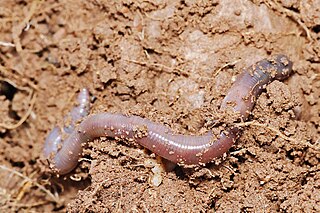| Acanthodrilidae | |
|---|---|
| Scientific classification | |
| Kingdom: | |
| Phylum: | |
| Class: | |
| Order: | |
| Suborder: | |
| Family: | Acanthodrilidae |
| Genera | |
See text | |
The Acanthodrilidae are an ancient and widely distributed family of earthworms which has native representatives in Australia, New Zealand, South Africa, South America, and North America. No native species are known from India (cf. Octochaetidae) nor Asia. The family possibly shows a pre-Pangaean distribution.

An earthworm is a tube-shaped, segmented worm found in the phylum Annelida. They have a world-wide distribution and are commonly found living in soil, feeding on live and dead organic matter. An earthworm's digestive system runs through the length of its body. It conducts respiration through its skin. It has a double transport system composed of coelomic fluid that moves within the fluid-filled coelom and a simple, closed blood circulatory system. It has a central and a peripheral nervous system. The central nervous system consists of two ganglia above the mouth, one on either side, connected to a nerve cord running back along its length to motor neurons and sensory cells in each segment. Large numbers of chemoreceptors are concentrated near its mouth. Circumferential and longitudinal muscles on the periphery of each segment enable the worm to move. Similar sets of muscles line the gut, and their actions move the digesting food toward the worm's anus.

Australia, officially the Commonwealth of Australia, is a sovereign country comprising the mainland of the Australian continent, the island of Tasmania, and numerous smaller islands. It is the largest country in Oceania and the world's sixth-largest country by total area. The neighbouring countries are Papua New Guinea, Indonesia, and East Timor to the north; the Solomon Islands and Vanuatu to the north-east; and New Zealand to the south-east. The population of 26 million is highly urbanised and heavily concentrated on the eastern seaboard. Australia's capital is Canberra, and its largest city is Sydney. The country's other major metropolitan areas are Melbourne, Brisbane, Perth, and Adelaide.

New Zealand is a sovereign island country in the southwestern Pacific Ocean. The country has two main landmasses—the North Island, and the South Island —and around 600 smaller islands. It has a total land area of 268,000 square kilometres (103,500 sq mi). New Zealand is about 2,000 kilometres (1,200 mi) east of Australia across the Tasman Sea and 1,000 kilometres (600 mi) south of the Pacific island areas of New Caledonia, Fiji, and Tonga. Because of its remoteness, it was one of the last lands to be settled by humans. During its long period of isolation, New Zealand developed a distinct biodiversity of animal, fungal, and plant life. The country's varied topography and its sharp mountain peaks, such as the Southern Alps, owe much to the tectonic uplift of land and volcanic eruptions. New Zealand's capital city is Wellington, and its most populous city is Auckland.
Membership requires an 'acanthodriline' arrangement of male pores and holoic nephridia.





